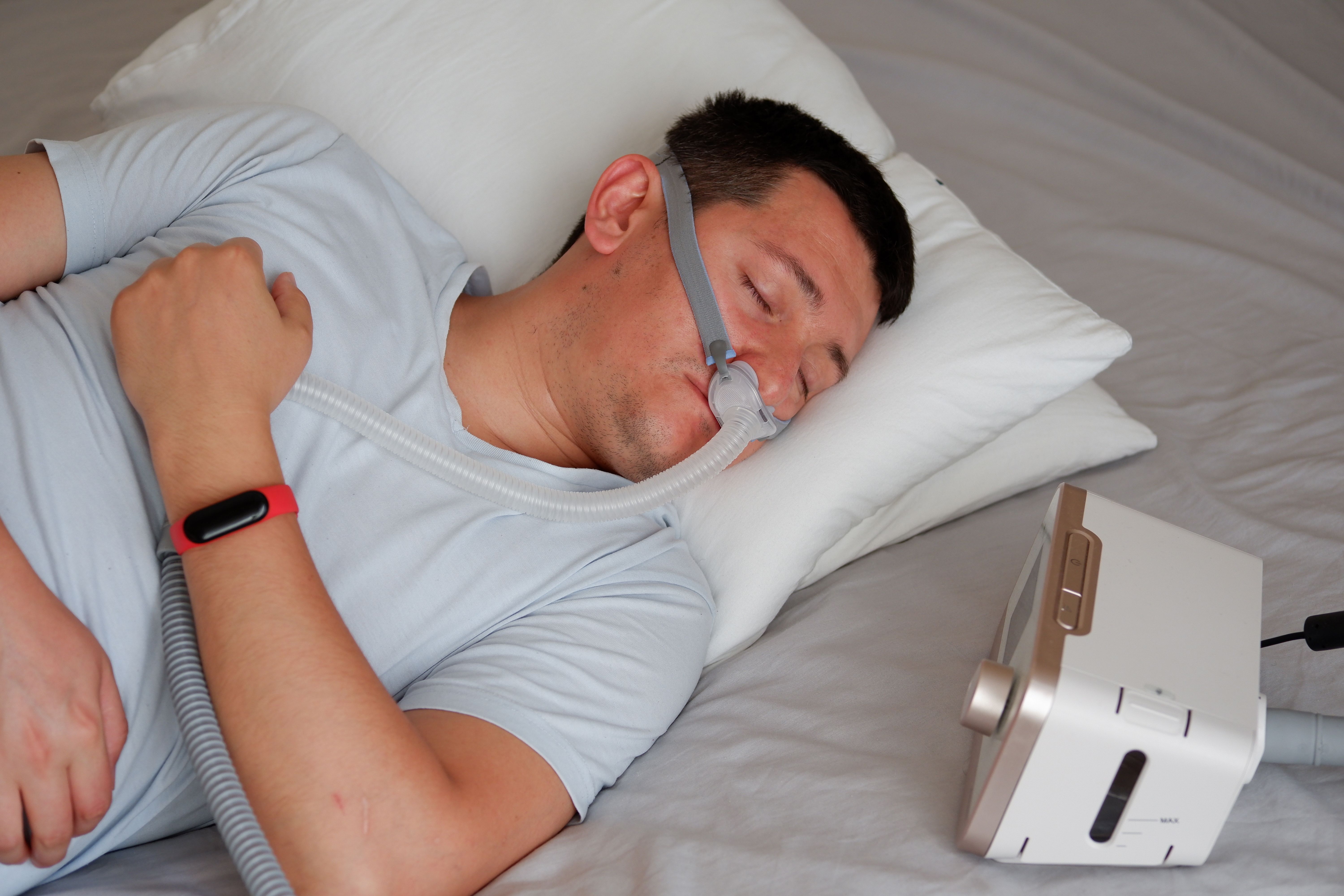Tirzepatide Shows Significant Reduction in Severity of Obstructive Sleep Apnea in Patients with Obesity
Phase III SURMOUNT-OSA trial data shows promise of tirzepatide, marketed as Zepbound and Mounjaro, treating the underlying disease in patients with moderate-to-severe obstructive sleep apnea.
Image credit: Ridvan | stock.adobe.com

Findings from the Phase III SURMOUNT-OSA (NCT05412004) clinical trial demonstrated the efficacy of Eli Lilly’s tirzepatide in lowering the severity of obstructive sleep apnea (OSA) in patients with obesity.1 Tirzepatide, marketed as Zepbound and Mounjaro, was the first approved medication for obesity that activates the glucose-dependent insulinotropic polypeptide (GIP) and glucagon-like peptide-1 (GLP-1) hormone receptors.
"OSA impacts 80 million adults in the US, with more than 20 million living with moderate-to-severe OSA. However, 85% of OSA cases go undiagnosed and therefore untreated," Jeff Emmick, MD, PhD, senior vice president of product development at Lilly, said in a press release. "Addressing this unmet need head-on is critical, and while there are pharmaceutical treatments for the excessive sleepiness associated with OSA, tirzepatide has the potential to be the first pharmaceutical treatment for the underlying disease."1
Zepbound was approved in November 2023 for adults with obesity with a BMI of 30 kg/m2 or greater, or overweight individuals with a BMI of 27 kg/m2 or greater who also have weight-related medical problems, including hypertension, dyslipidemia, type 2 diabetes mellitus, OSA, or cardiovascular disease.2 Preclinical and clinical trials have shown that dual GIP/GLP-1 agonist therapy produces superior glucose control and weight loss compared to selective GLP-1 receptor agonists.3
The multi-center, randomized, double-blind, parallel, placebo-master protocol SURMOUNT-OSA trial evaluated the efficacy and safety of tirzepatide vs. placebo in adult patients with moderate-to-severe OSA and obesity who were unable or unwilling to use positive airway pressure (PAP) therapy as part of Study 1; and in patients who planned to stay on PAP throughout the duration of the trial as part of Study 2.
Investigators randomly assigned 489 participants at a 1:1 ratio to receive tirzepatide injection at maximum tolerated dose (MTD) of 10 mg, 15 mg, or placebo. The primary objective for both studies was to show the superiority of tirzepatide vs. placebo in change in apnea-hypopnea index (AHI) from baseline at 52 weeks. Those who tolerated the 15 mg dose continued on it as their MTD, whereas those who tolerated the 10 mg dose but did not tolerate 15 mg continued on 10 mg as MTD.
In SURMOUNT-OSA Study 1, at 52 weeks, tirzepatide achieved the trial’s primary endpoint in lowering mean AHI from baseline, at 27.4 events per hour compared with 4.8 events per hour in the placebo cohort. For the trial’s key secondary outcomes, patients administered tirzepatide experienced a mean AHI decrease from baseline of 55.0% compared to 5.0% from baseline in the placebo cohort. Further, tirzepatide produced a mean body weight reduction of 18.1% from baseline vs. 1.3% from baseline in the placebo cohort.
In SURMOUNT-OSA Study 2, at 52 weeks, patients administered tirzepatide experienced a mean AHI decrease from baseline of 30.4 events per hour vs. 6.0 events per hour in the placebo cohort. For key secondary outcomes of Study 2, patients administered tirzepatide experienced a mean AHI decrease from baseline of 62.8% vs. 6.4% from baseline in the placebo cohort. Further, patients administered tirzepatide experienced a mean body weight decrease of 20.1% from baseline vs. 2.3% from baseline in the placebo cohort.
In terms of safety, the profile of tirzepatide in the SURMOUNT-OSA studies was similar to what has previously been reported in clinical trials of the drug. In Study 1, the most frequently reported adverse events (AEs) for patients administered tirzepatide were diarrhea, nausea, and vomiting, whereas in Study 2, the most common AEs were diarrhea, nausea, and constipation.
References
1. Tirzepatide reduced sleep apnea severity by up to nearly two-thirds in adults with obstructive sleep apnea (OSA) and obesity. News release. Eli Lilly & Company. April 17, 2024. Accessed April 17, 2024. https://investor.lilly.com/news-releases/news-release-details/tirzepatide-reduced-sleep-apnea-severity-nearly-two-thirds
2. FDA Approves Lilly's Zepbound™ (tirzepatide) for Chronic Weight Management, a Powerful New Option for the Treatment of Obesity or Overweight with Weight-Related Medical Problems. Eli Lilly and Company. News release. November 8, 2023. Accessed April 17, 2024. https://investor.lilly.com/news-releases/news-release-details/fda-approves-lillys-zepboundtm-tirzepatide-chronic-weight
3. Rosenstock, J, et. al. Efficacy and safety of a novel dual GIP and GLP-1 receptor agonist tirzepatide in patients with type 2 diabetes (SURPASS-1): a double-blind, randomised, phase 3 trial. Lancet. 2021;398(10295):143-155. doi: 10.1016/S0140-6736(21)01324-6. Accessed April 17, 2024.
Improving Relationships and Diversifying the Site Selection Process
April 17th 2025In this episode of the Applied Clinical Trials Podcast, Liz Beatty, co-founder and chief strategy officer, Inato, discusses a number of topics around site engagement including community-based sites, the role of technology in improving site/sponsor relationships, how increased operational costs are impacting the industry, and more.
Behind the Buzz: Why Clinical Research Leaders Flock to SCOPE Summit
February 7th 2025In this episode, we meet with Micah Lieberman, Executive Conference Director for SCOPE Summit (Summit for Clinical Ops Executives) at Cambridge Innovation Institute. We will dive deep into the critical role of collaboration within the clinical research ecosystem. How do we bring together diverse stakeholders—sponsors, CROs, clinical trial tech innovators, suppliers, patients, sites, advocacy organizations, investors, and non-profits—to share best practices in trial design, program planning, innovation, and clinical operations? We’ll explore why it’s vital for thought leaders to step beyond their own organizations and learn from others, exchanging ideas that drive advancements in clinical research. Additionally, we’ll discuss the pivotal role of scientific conferences like SCOPE Summit in fostering these essential connections and collaborations, helping shape the future of clinical trials. Join us as we uncover how collective wisdom and cross-industry partnerships are transforming the landscape of clinical research.
FDA-Approved Gene Therapy Beqvez Shows Sustained Efficacy, Safety in Long-Term Hemophilia B Trial
April 17th 2025Beqvez (fidanacogene elaparvovec), an FDA-approved one-time gene therapy for hemophilia B, demonstrated sustained factor IX expression, low bleeding rates, and a favorable safety profile over long-term follow-up.